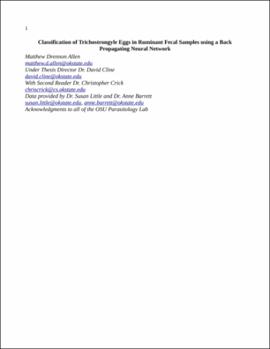| dc.contributor.author | Allen, Matthew Drennon | |
| dc.date.accessioned | 2017-10-10T20:56:48Z | |
| dc.date.available | 2017-10-10T20:56:48Z | |
| dc.date.issued | 2016-12-08 | |
| dc.identifier | oksd_allen_HT_2016 | |
| dc.identifier.uri | https://hdl.handle.net/11244/52295 | |
| dc.description.abstract | This article examines the use of a back-propagating neural network to count the number of parasite eggs present in a given fecal sample. If possible this would save hours of trained labor currently used for the task and potentially improve the accuracy of the procedure. The preliminary results of this study showed that the procedure could be performed with an error rate of less than five percent by a properly trained and configured network. Further study is needed to determine whether the method is viable for more expansive data sets, and whether the current configuration is optimal. | |
| dc.format | application/pdf | |
| dc.language | en_US | |
| dc.rights | Copyright is held by the author who has granted the Oklahoma State University Library the non-exclusive right to share this material in its institutional repository. Contact Digital Library Services at lib-dls@okstate.edu or 405-744-9161 for the permission policy on the use, reproduction or distribution of this material. | |
| dc.title | Classification of trichostrongyle eggs in ruminant fecal samples using a back propagating neural network | |
| osu.filename | oksd_allen_HT_2016.pdf | |
| osu.accesstype | Open Access | |
| dc.type.genre | Honors Thesis | |
| dc.type.material | Text | |
| dc.contributor.director | Cline, David | |
| dc.contributor.facultyreader | Crick, Christopher | |
| thesis.degree.discipline | Computer Science | |
| thesis.degree.grantor | Oklahoma State University | |
